Roles of Air–Sea Interactions in the Predictability of Typhoon Mawar and Remote Heavy-Rainfall Events after Five Days
Abstract
:1. Introduction
1.1. Typhoon Mawar and the Quasi-Stationary Front
1.2. Predictability of Typhoon Mawar
1.3. Research Purposes
2. Data and Methods
3. Results
3.1. Results of Global Model Predictions
3.2. Simulation Results by a Regional Model
3.3. Mechanisms of TC Motion and Heavy Rainfall
4. Discussion
5. Conclusions
Funding
Institutional Review Board Statement
Informed Consent Statement
Data Availability Statement
Acknowledgments
Conflicts of Interest
References
- Makihara, Y. A method for improving radar estimates of precipitation by comparing data from radars and raingauges. J. Meteorol. Soc. Jpn. 1996, 74, 459–480. [Google Scholar] [CrossRef]
- Yoshida, N.; Kawamura, R.; Kawano, T.; Mochizuki, T.; Iizuka, S. Remote dynamic and thermodynamic effects of typhoons on Meiyu–Baiu precipitation in Japan assessed with bogus typhoon experiments. Weather Clim. Extrem. 2023, 41, 100578. [Google Scholar] [CrossRef]
- Kodama, S.; Satoh, M. Statistical analysis of remote precipitation in Japan caused by typhoons in September. J. Meteorol. Soc. Jpn. 2022, 100, 893–911. [Google Scholar] [CrossRef]
- Yoshida, K.; Ito, H. Indirect effects of tropical cyclones on heavy rainfall events in Kyushu, Japan, during the Baiu season. J. Meteorol. Soc. Jpn. 2012, 90, 377–401. [Google Scholar] [CrossRef]
- Schumacher, R.S.; Galarneau, T.J.; Bosart, L.F. Distant effects of a recurving tropical cyclone on rainfall in a midlatitude convective system: A high-impact predecessor rain event. Mon. Weather Rev. 2011, 139, 650–667. [Google Scholar] [CrossRef]
- Knippertz, P.; Martin, J.E. A pacific moisture conveyor belt and its relationship to a significant precipitation event in the semiarid southwestern united states. Weather Forecast 2007, 22, 125–144. [Google Scholar] [CrossRef]
- American Meteorological Society. Atmospheric River. Glossary of Meteorology. Available online: http://glossary.ametsoc.org/wiki/Atmospheric_river (accessed on 15 September 2023).
- THORPEX Interactive Grand Global Ensemble (TIGGE) Model Tropical Cyclone Track Data. Available online: https://rda.ucar.edu/datasets/ds330.3/dataaccess/ (accessed on 15 September 2023).
- Ikawa, M.; Saito, K. Description of a nonhydrostatic model developed at the forecast research department of the MRI. Tech. Rep. MRI 1991, 28, 238. [Google Scholar] [CrossRef]
- Lin, Y.L.; Farley, R.D.; Orville, H.D. Bulk parameterization of the snow field in a cloud model. J. Appl. Meteorol. Climatol. 1983, 22, 1065–1092. [Google Scholar] [CrossRef]
- Kondo, J. Air-sea bulk transfer coefficients in diabatic conditions. Bound.-Layer Meteorol. 1975, 9, 91–112. [Google Scholar] [CrossRef]
- Taylor, P.K.; Yelland, M.J. The dependence of sea surface roughness on the height and steepness of the waves. J. Phys. Oceanogr. 2001, 31, 572–590. [Google Scholar] [CrossRef]
- Wada, A.; Kanada, S.; Yamada, H. Effect of air-sea environmental conditions and interfacial processes on extremely intense typhoon Haiyan (2013). J. Geophys. Res. 2018, 123, 10379–10405. [Google Scholar] [CrossRef]
- Klemp, J.B.; Wilhelmson, R. The simulation of three-dimensional convective storm dynamics. J. Atmos. Sci. 1978, 35, 1070–1096. [Google Scholar] [CrossRef]
- Deardorff, J.W. Stratocumulus-capped mixed layers derived from a three-dimensional model. Bound.-Layer Meteorol. 1980, 18, 495–527. [Google Scholar] [CrossRef]
- Sugi, M.; Kuma, K.; Tada, K.; Tamiya, K.; Hasegawa, N.; Iwasaki, T.; Yamada, S.; Kitade, T. Description and performance of the JMA operational global spectral model (JMA-GSM88). Geophys. Mag. 1990, 43, 105–130. [Google Scholar]
- Saito, K. The JMA nonhydrostatic model and its applications to operation and research. In Atmospheric Model Applications; Yucel, I., Ed.; InTech: Houston, TX, USA, 2012; pp. 85–110. [Google Scholar] [CrossRef]
- Japan Meteorological Agency. Outline of the operational numerical weather prediction at the Japan Meteorological Agency. In Appendix to WMO Technical Progress Report on the Global Data-Processing and Forecasting System (GDPFS) and Numerical Weather Prediction (NWP) Research; Japan Meteorological Agency: Tokyo, Japan, 2013; 201p. [Google Scholar]
- Bender, M.A.; Ginis, I.; Kurihara, Y. Numerical simulations of tropical cyclone-ocean interaction with a high-resolution coupled model. J. Geophys. Res. 1993, 98, 23245–23263. [Google Scholar] [CrossRef]
- Schiller, A.; Godfrey, J.S. A diagnostic model of the diurnal cycle of sea surface temperature for use in coupled ocean-atmosphere models. J. Geophys. Res. 2005, 110, C11014. [Google Scholar] [CrossRef]
- Ohlmann, J.C.; Siegel, D.A. Ocean radiant heating. Part II: Parameterizing solar radiation transmission through the upper ocean. J. Phys. Oceanogr. 2000, 30, 1849–1865. [Google Scholar] [CrossRef]
- Remote Sensing Systems Measurement Sea Surface Temperature. Available online: https://www.remss.com/measurements/sea-surface-temperature/ (accessed on 15 September 2023).
- Usui, N.; Wakamatsu, T.; Tanaka, Y.; Hirose, N.; Toyoda, T.; Nishikawa, S.; Fujii, Y.; Takatsuki, Y.; Igarashi, H.; Nishikawa, H.; et al. Four–dimensional variational ocean reanalysis: A 30–year high–resolution dataset in the western North Pacific (FORA–WNP30). J. Oceanogr. 2017, 73, 205–233. [Google Scholar] [CrossRef]
- Wada, A.; Chan, J.C.L. Increasing TCHP in the western North Pacific and its influence on the intensity of FAXAI and HAGIBIS in 2019. SOLA 2021, 17A, 29–32. [Google Scholar] [CrossRef]
- Chan, J.C.L. The physics of tropical cyclone motion. Annu. Rev. Fluid Mech. 2005, 37, 99–128. [Google Scholar] [CrossRef]
- Kobayashi, S.; Kosaka, Y.; Chiba, J.; Tokuhiro, T.; Harada, Y.; Kobayashi, C.; Naoe, H. JRA-3Q: Japanese Reanalysis for Three Quarters of a Century. In Proceedings of the Joint WCRP-WWRP Symposium on Data Assimilation and Reanalysis/ECMWF Annual Seminar 2021, Online, 16 September 2021. [Google Scholar]
- Hersbach, H.; Bell, B.; Berrisford, P.; Hirahara, S.; Horányi, A.; Muñoz-Sabater, J.; Nicolas, J.; Peubey, C.; Radu, R.; Schepers, D.; et al. The ERA5 global reanalysis. Q. J. R. Meteorol Soc. 2020, 146, 1999–2049. [Google Scholar] [CrossRef]
- Yonehara, H.; Kuroki, Y.; Ujiie, M.; Matsukawa, C.; Kanehama, T.; Nagasawa, R.; Ochi, K.; Higuchi, M.; Ichikawa, Y.; Sekiguchi, R.; et al. Upgrade of JMA’s operational global numerical weather prediction system. WGNE Res. Activ. Earth Syst. Modell. 2023, 53, 6-15–6-16. [Google Scholar]
- Bender, M.A.; Ginis, I. Real-case simulations of hurricane–ocean interaction using a high-resolution coupled model: Effects on hurricane intensity. Mon. Weather Rev. 2000, 128, 917–946. [Google Scholar] [CrossRef]
- Ito, K.; Kuroda, T.; Saito, K.; Wada, A. Forecasting a large number of tropical cyclone intensities around Japan using a high-resolution atmosphere–ocean coupled model. Weather Forecast 2015, 30, 793–808. [Google Scholar] [CrossRef]
- Wada, A.; Uehara, T.; Ishizaki, S. Typhoon-induced sea surface cooling during the 2011 and 2012 typhoon seasons: Observational evidence and numerical investigations of the sea surface cooling effect using typhoon simulations. Prog. Earth Planet. Sci. 2014, 1, 11. [Google Scholar] [CrossRef]
- Davis, C.A.; Emanuel, K.A. Potential vorticity diagnostics of cyclogenesis. Mon. Weather Rev. 1991, 119, 1929–1953. [Google Scholar] [CrossRef]
- Wada, A.; Yanase, W.; Okamoto, K. Interactions between a tropical cyclone and upper-tropospheric cold-core lows simulated by an atmosphere-wave-ocean coupled model: A case study of Typhoon Jongdari (2018). J. Meteorol. Soc. Jpn. 2022, 100, 387–414. [Google Scholar] [CrossRef]
- Mogensen, K.S.; Magnusson, L.; Bidlot, J.-R. Tropical cyclone sensitivity to ocean coupling in the ECMWF coupled model. J. Geophys. Res. Ocean. 2017, 122, 4392–4412. [Google Scholar] [CrossRef]
- Met Office Numerical Weather Prediction Models. Available online: https://www.metoffice.gov.uk/research/approach/modelling-systems/unified-model/weather-forecasting (accessed on 15 September 2023).
- Yablonsky, R.M.; Ginis, I. Limitation of one-dimensional ocean models for coupled hurricane-ocean model forecasts. Mon. Weather Rev. 2009, 137, 4410–4419. [Google Scholar] [CrossRef]
- Kawai, Y.; Wada, A. Diurnal sea surface temperature variation and its impact on the atmosphere and ocean: A review. J. Oceanogr. 2007, 63, 721–744. [Google Scholar] [CrossRef]
- American Meteorological Society. Monsoon Gyre. Glossary of Meteorology. Available online: https://glossary.ametsoc.org/wiki/Monsoon_gyre (accessed on 15 September 2023).


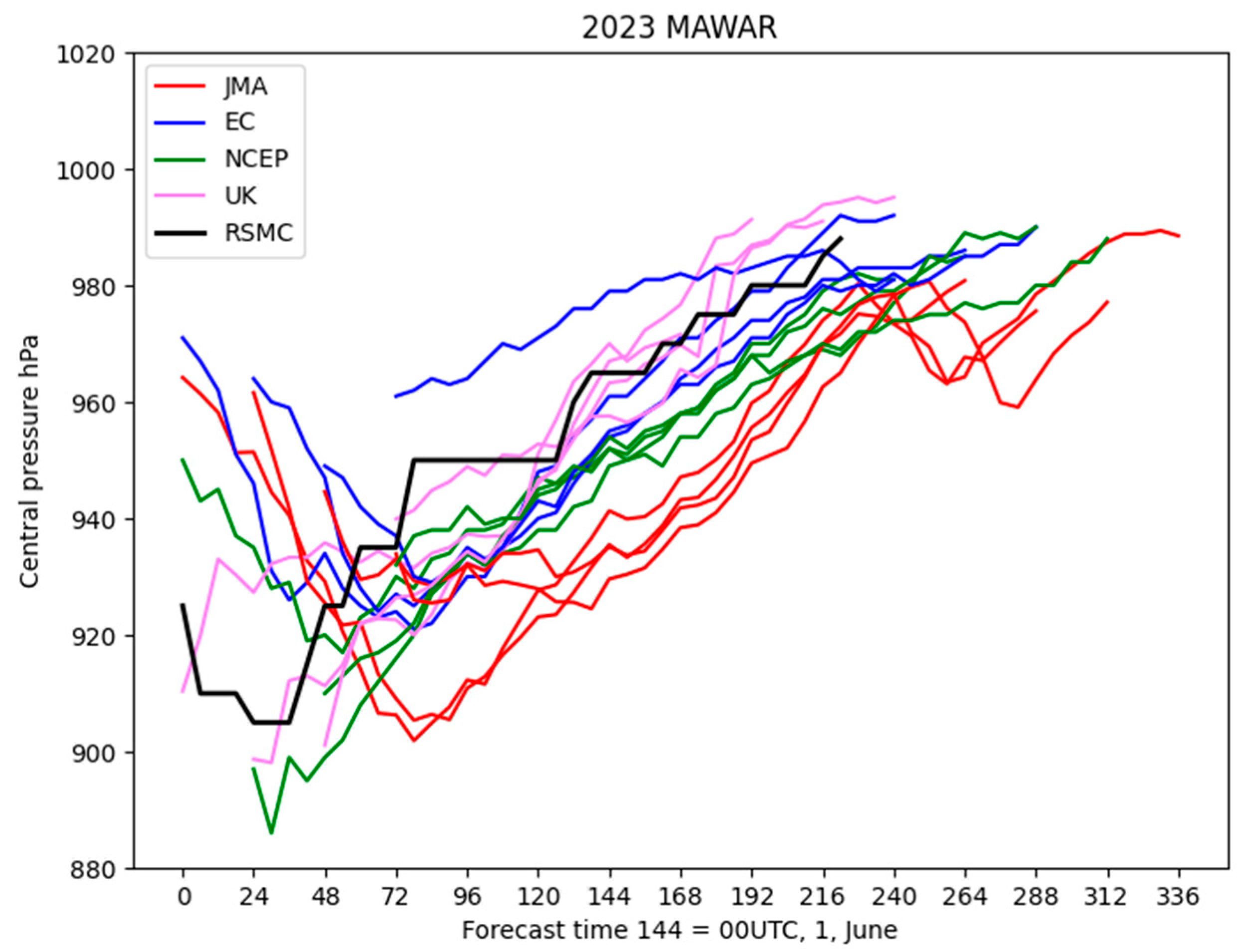
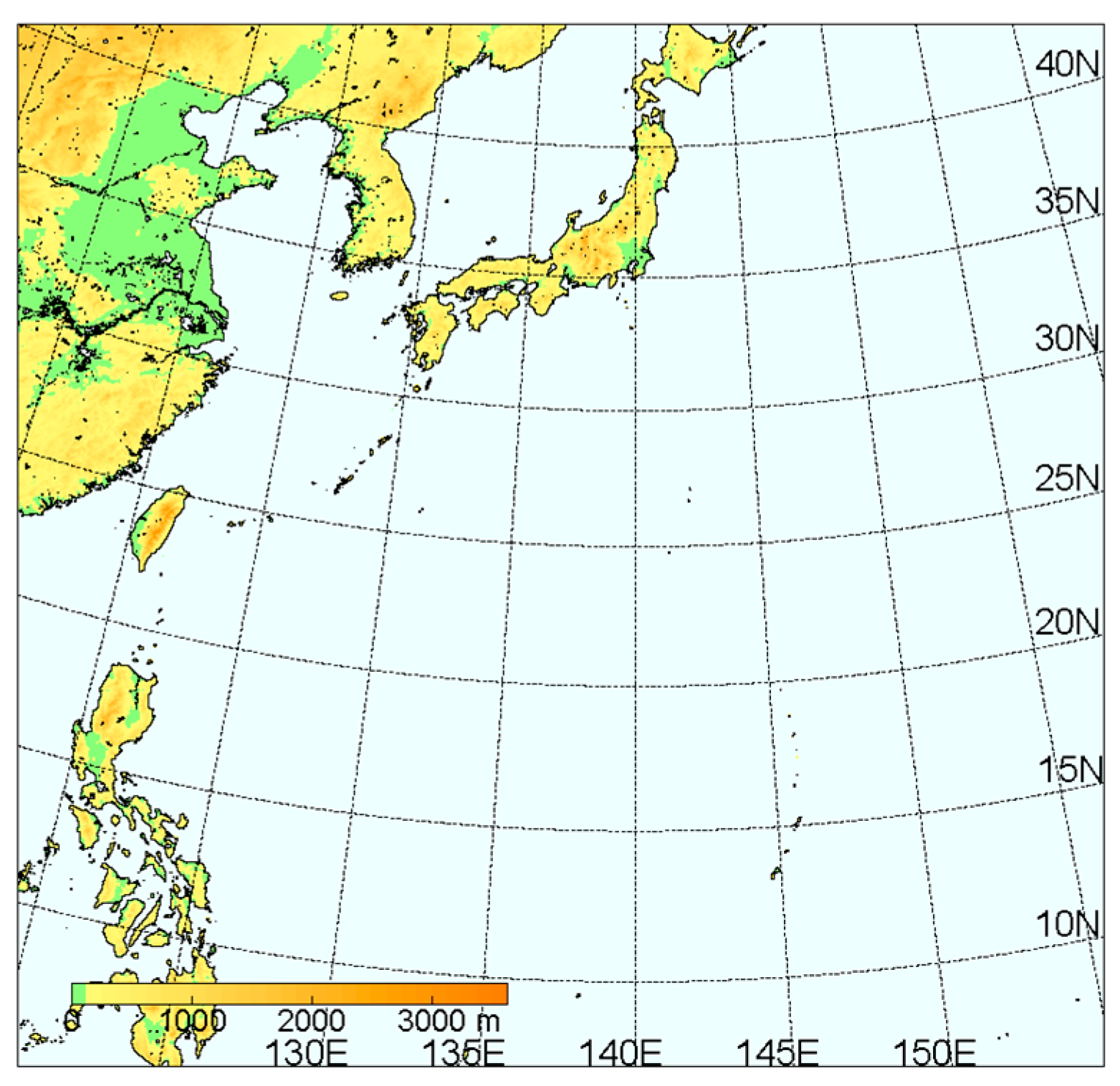
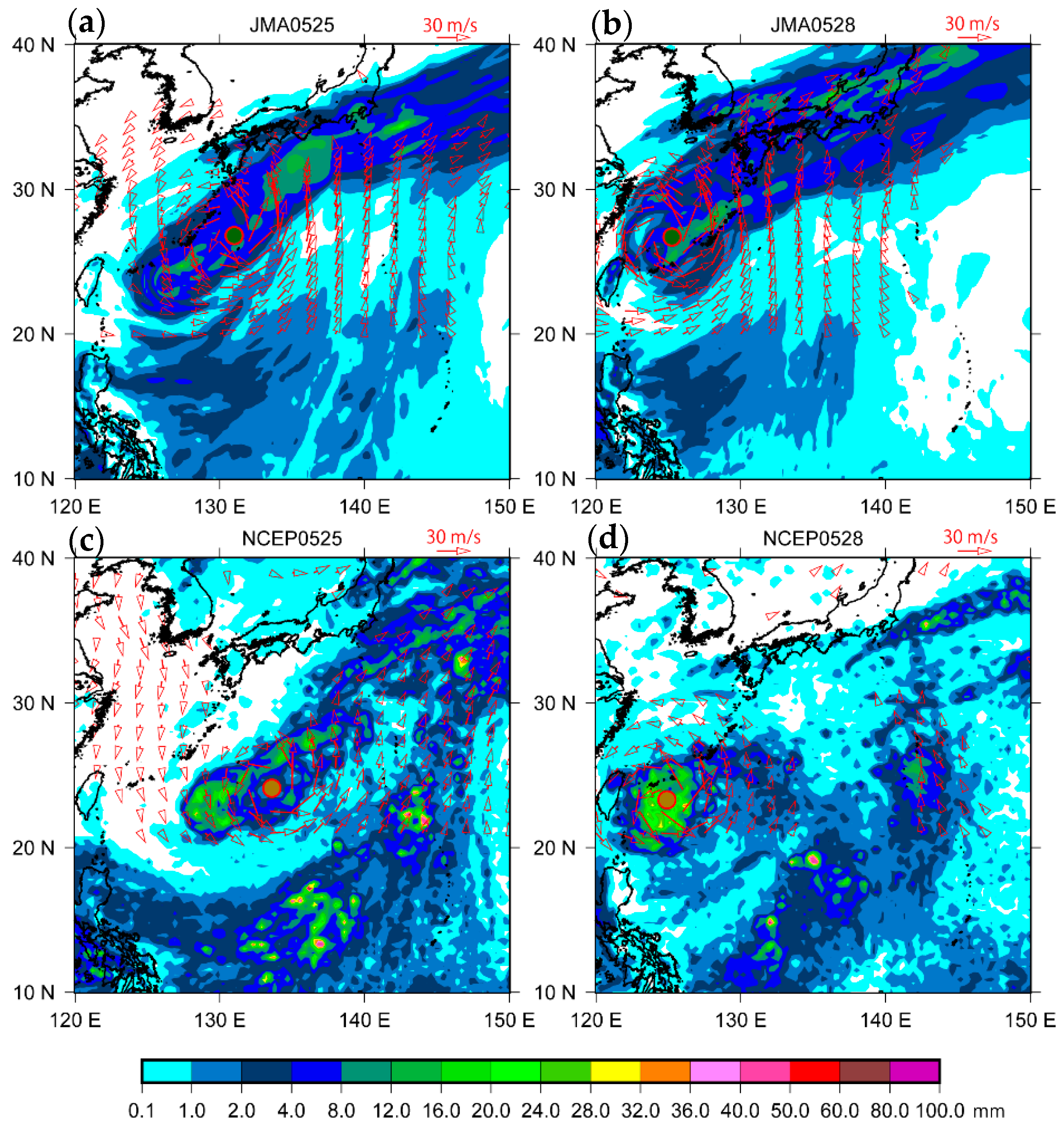
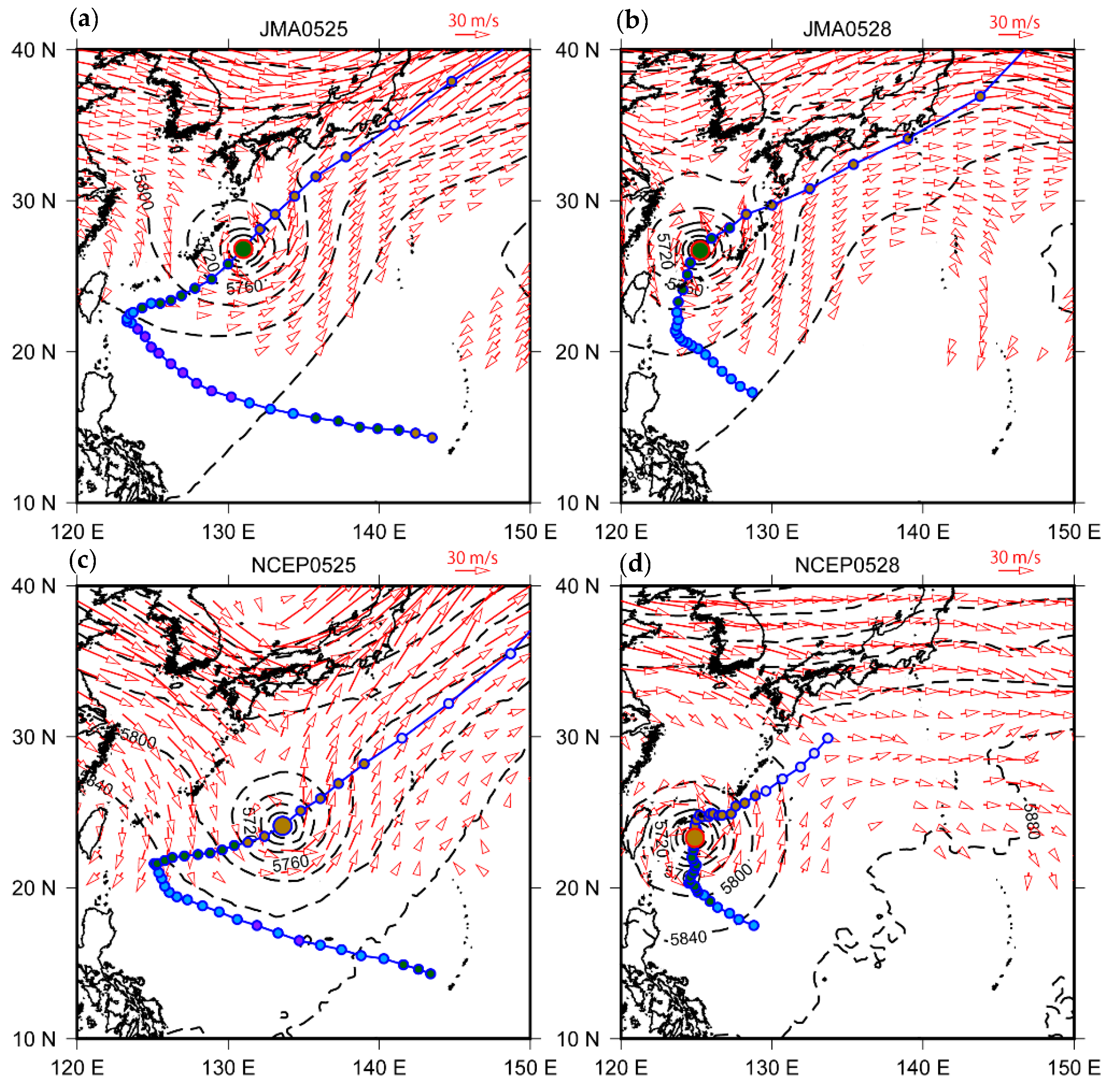
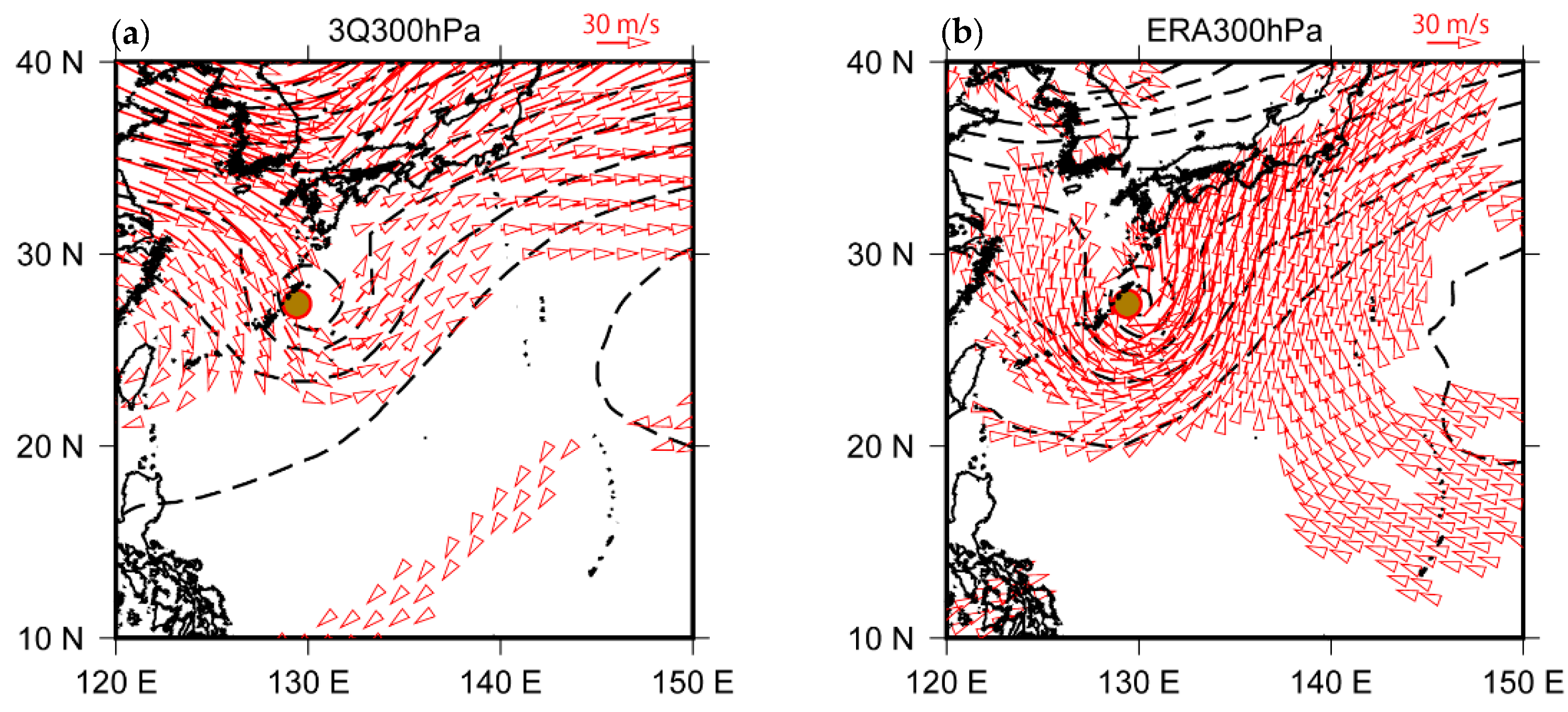
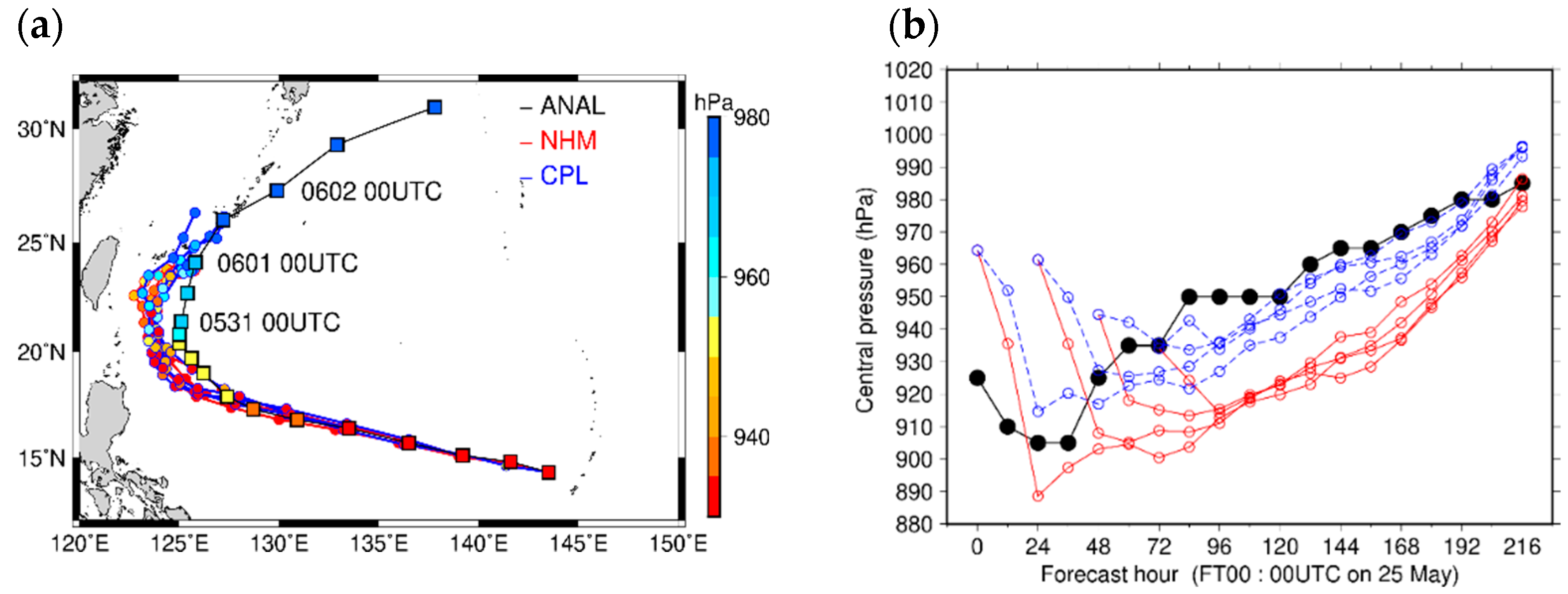



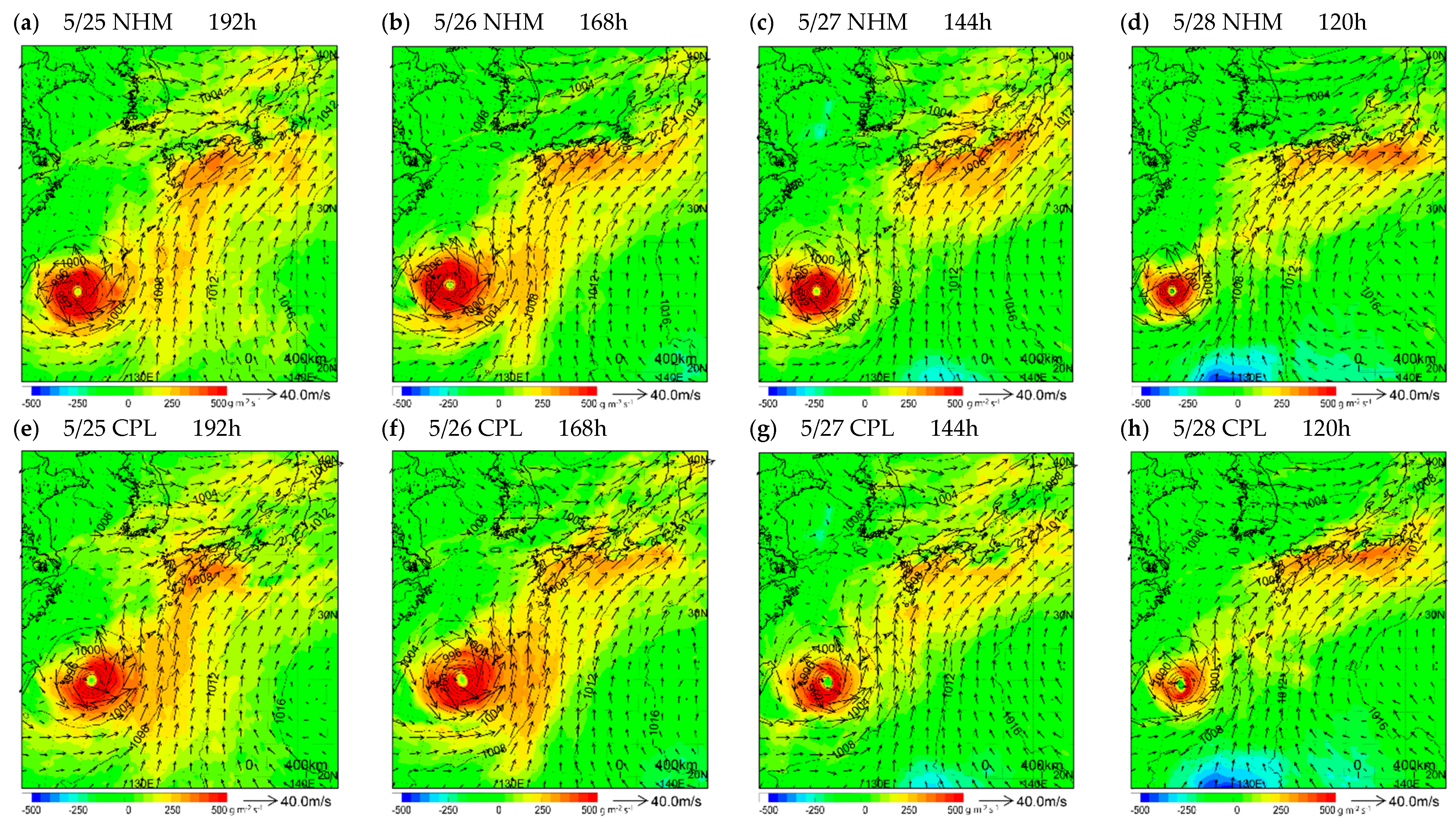

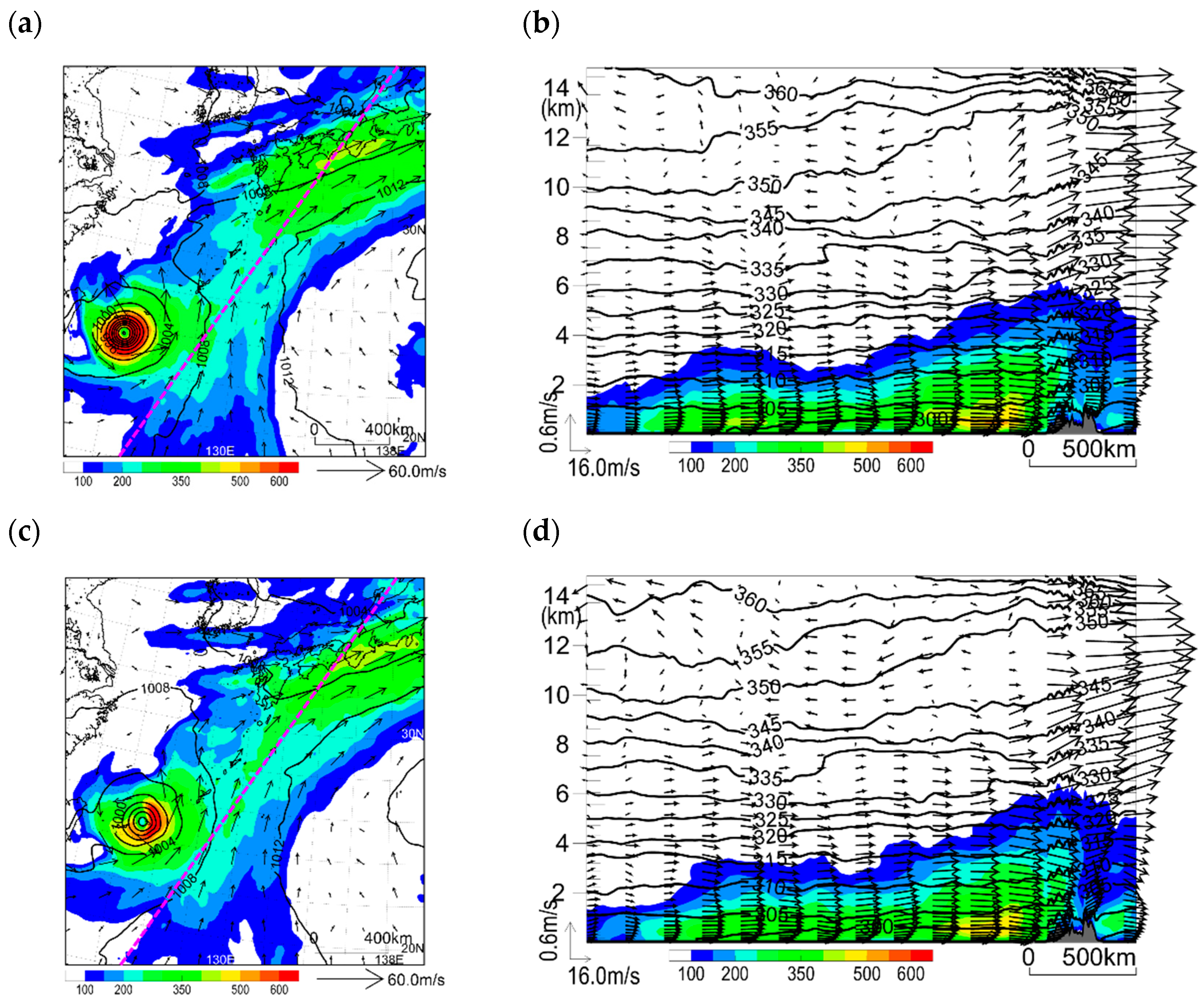
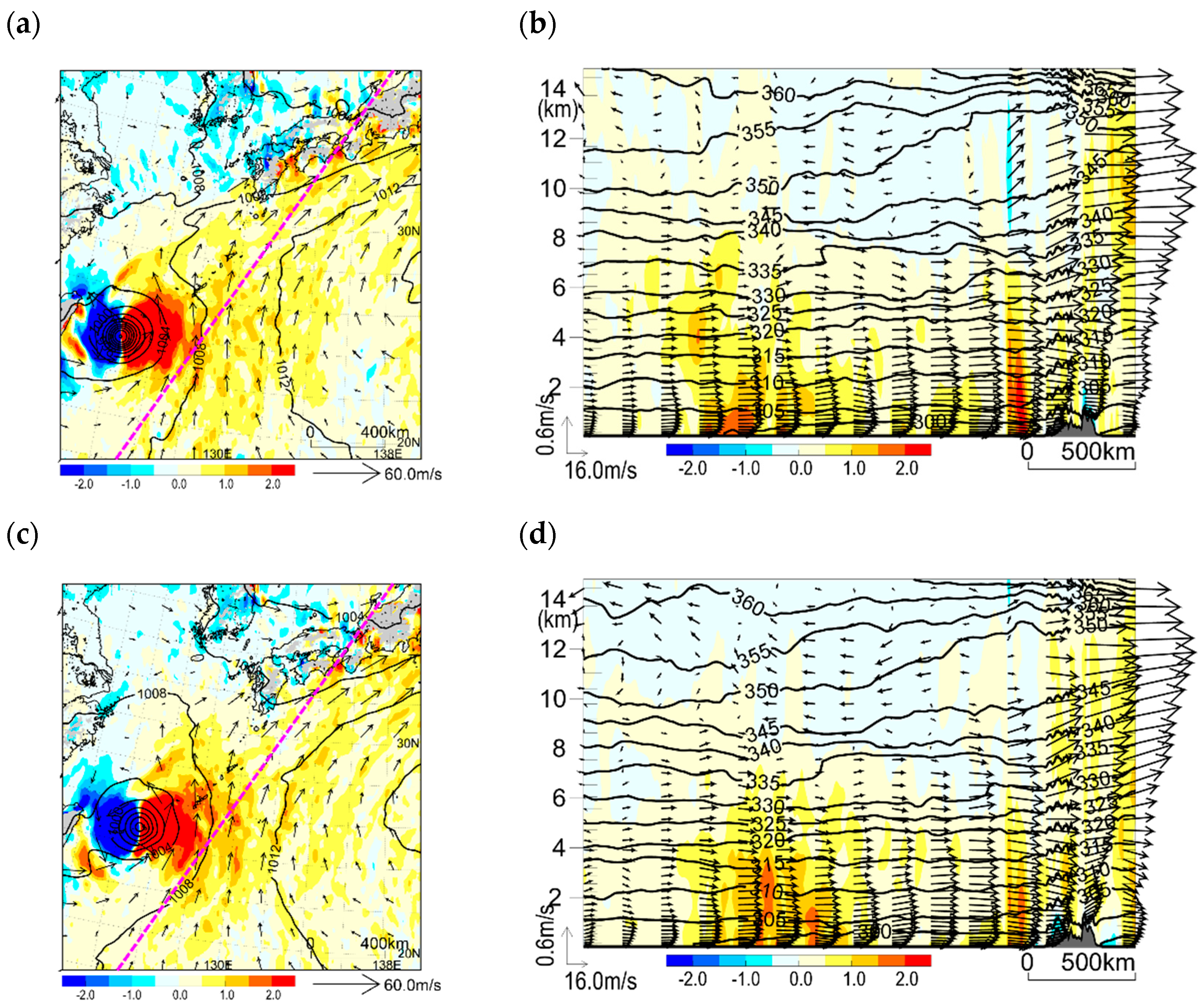
| ECMWF | JMA | NCEP | UKMet | |
|---|---|---|---|---|
| Model (Atmosphere) | Integrated Forecasting System (IFS) Cycle 47r3 | Global Spectral Model | Global Forecast System Forecast System v16.3 | Unified model Operational Suite Cycle 45 |
| Model (Ocean) | Nucleus for European Modelling of the Ocean (NEMO) | Nucleus for European Modelling of the Ocean (NEMO) | ||
| SST | Merged Satellite and In-situ Data Global Daily Sea Surface Temperature (MGDSST) | Near-Surface Sea Temperature (NSST) | ||
| Model (Wave) | High RESolution WAve Model (HRES-WAM) | |||
| Horizontal resolution and Vertical level (Atmosphere) | ~9 km (Top 0.01 hPa) Tco1279L137 | ~13 km (Top 0.01 hPa) TQ959L128 | 13 km L127 (Top 80 km) | 10 km L70 (Top 80 km) |
| Horizontal resolution (Ocean) | 28 km | 0.25 degrees | 1/12 degrees | 0.25 degrees |
| Forecast time at 00 UTC | 10 days | 11 days | 16 days | 7 days |
| NHM | CPL | |
|---|---|---|
| Model | A nonhydrostatic atmosphere model | Coupled atmosphere–wave–ocean model |
| Microphysics | Ikawa and Saito (1991) [9], Lin et al. (1983) [10]. | |
| Surface flux | Kondo (1975) [11] | Taylor and Yelland (2001) [12], Wada et al. (2018) [13] |
| Turbulence | Klemp and Wilhelmson (1978) [14], Deardorff (1980) [15] | |
| Radiation | Sugi et al. (1990) [16] | |
| NHM | CPL | |
|---|---|---|
| Initial and integration times | From 00 UTC on 25, 26, 27, 28 May to 00 UTC on 4 June in 2023 | |
| Time step | 6 s | 6 s (Atmosphere), 36 s (Ocean), 6 min (Ocean wave) |
| Computational domain and map system | 4500 km (zonal) and 4320 km (meridional) centered at 25° N, 137° E, Lambert Conformal Conic projection | |
| Horizontal resolution and vertical layer | 3 km and 55 levels in vertical coordinates with intervals ranging from 40 m for the near-surface layer to 1180 m for the uppermost layer (top height is 27,440 m) | |
| Initial data for SST | Daily microwave sea surface temperature on 24, 25, 26, and 27 May in 2023 (1 day before the initial time) | |
| Initial and boundary conditions for the ocean model (temperature, salinity, and current velocities) | - | JMA mean North Pacific oceanic daily analysis on 24, 25, 26, and 27 May in 2023 |
| Initial and boundary conditions for the atmosphere model | JMA 6 hourly global model products with a horizontal grid spacing of approximately 10 km | |
Disclaimer/Publisher’s Note: The statements, opinions and data contained in all publications are solely those of the individual author(s) and contributor(s) and not of MDPI and/or the editor(s). MDPI and/or the editor(s) disclaim responsibility for any injury to people or property resulting from any ideas, methods, instructions or products referred to in the content. |
© 2023 by the author. Licensee MDPI, Basel, Switzerland. This article is an open access article distributed under the terms and conditions of the Creative Commons Attribution (CC BY) license (https://creativecommons.org/licenses/by/4.0/).
Share and Cite
Wada, A. Roles of Air–Sea Interactions in the Predictability of Typhoon Mawar and Remote Heavy-Rainfall Events after Five Days. Atmosphere 2023, 14, 1638. https://doi.org/10.3390/atmos14111638
Wada A. Roles of Air–Sea Interactions in the Predictability of Typhoon Mawar and Remote Heavy-Rainfall Events after Five Days. Atmosphere. 2023; 14(11):1638. https://doi.org/10.3390/atmos14111638
Chicago/Turabian StyleWada, Akiyoshi. 2023. "Roles of Air–Sea Interactions in the Predictability of Typhoon Mawar and Remote Heavy-Rainfall Events after Five Days" Atmosphere 14, no. 11: 1638. https://doi.org/10.3390/atmos14111638
APA StyleWada, A. (2023). Roles of Air–Sea Interactions in the Predictability of Typhoon Mawar and Remote Heavy-Rainfall Events after Five Days. Atmosphere, 14(11), 1638. https://doi.org/10.3390/atmos14111638








